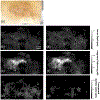Infrared imaging confirms the role of the transparent surface zone in arresting dental caries
- PMID: 33767521
- PMCID: PMC7989780
- DOI: 10.1117/12.2584907
Infrared imaging confirms the role of the transparent surface zone in arresting dental caries
Abstract
Several studies have demonstrated the potential of short wavelength infrared (SWIR) reflectance, thermal imaging and optical coherence tomography for the nondestructive assessment of the activity of caries lesions. The purpose of this study was to test the hypothesis that the activity of arrested caries lesions on the coronal surfaces of extracted teeth would be changed by reducing the thickness of the highly mineralized transparent surface layer, which was measured using polarization sensitive optical coherence tomography (PS-OCT). The lesion activity was assessed using SWIR reflectance and thermal imaging during forced air drying of the lesion before and after mechanical removal of a surface layer ~ 50-μm thick covering the lesion. Both the intensity change in SWIR reflectance images at 1500-1750-nm wavelengths after drying the lesions and the change in thermal emission measured with a thermal camera at 8-13-μm wavelengths increased significantly (P<0.05) after reducing the thickness of the mineralized surface layer in the lesions indicating the permeability of the lesion to fluids increased. These results provide further evidence that the presence of a highly mineralized outer surface layer is a key indicator of lesion arrest.
Keywords: SWIR imaging; lesion activity; optical coherence tomography; thermal imaging.
Figures



Similar articles
-
Dynamic SWIR imaging near the 1950-nm water absorption band for caries lesion diagnosis.J Biomed Opt. 2021 May;26(5):056006. doi: 10.1117/1.JBO.26.5.056006. J Biomed Opt. 2021. PMID: 34032036 Free PMC article.
-
Assessment of the activity of secondary caries lesions with short-wavelength infrared, thermal, and optical coherence tomographic imaging.J Biomed Opt. 2023 Sep;28(9):094801. doi: 10.1117/1.JBO.28.9.094801. Epub 2023 Jan 10. J Biomed Opt. 2023. PMID: 36761935 Free PMC article.
-
Monitoring lesion activity on primary teeth with CP-OCT and SWIR reflectance imaging.Lasers Surg Med. 2023 Aug;55(6):601-609. doi: 10.1002/lsm.23677. Epub 2023 May 12. Lasers Surg Med. 2023. PMID: 37172310
-
Assessment of the activity of root caries lesions using short wavelength infrared imaging - an in vitro pilot study.J Dent. 2025 Jun;157:105769. doi: 10.1016/j.jdent.2025.105769. Epub 2025 Apr 17. J Dent. 2025. PMID: 40252948
-
Thermal Imaging of Root Caries In Vivo.J Dent Res. 2020 Dec;99(13):1502-1508. doi: 10.1177/0022034520951157. Epub 2020 Aug 31. J Dent Res. 2020. PMID: 32866422 Free PMC article.
Cited by
-
Dynamic SWIR imaging near the 1950-nm water absorption band for caries lesion diagnosis.J Biomed Opt. 2021 May;26(5):056006. doi: 10.1117/1.JBO.26.5.056006. J Biomed Opt. 2021. PMID: 34032036 Free PMC article.
-
Emissivity evaluation of human enamel and dentin.Front Physiol. 2022 Oct 24;13:993674. doi: 10.3389/fphys.2022.993674. eCollection 2022. Front Physiol. 2022. PMID: 36353375 Free PMC article.
-
Time-resolved SWIR imaging for the assessment of the activity of occlusal caries lesions.J Biophotonics. 2023 Oct;16(10):e202300165. doi: 10.1002/jbio.202300165. Epub 2023 Jun 22. J Biophotonics. 2023. PMID: 37316468 Free PMC article.
References
-
- Petersen PE The World Oral Health Report 2003: continuous improvement of oral health in the 21st century – the approach of the WHO Global Oral Health Programme, Community Dentistry and Oral Epidemiology 2003, 31, 3–23. - PubMed
-
- Alfano R; Lam W; Zarrabi H; Alfano M; Cordero J Human teeth with and without caries studied by laser scattering, fluorescence, and absorption spectroscopy, IEEE J. Quantum Elect 1984, 20, 1512–1516 [doi:10.1109/JQE.1984.1072351]. - DOI
-
- Ten CJ; Featherstone JD Mechanistic aspects of the interactions between fluoride and dental enamel, Crit Rev Oral Biol Med 1991, 2, 283–296 - PubMed
Grants and funding
LinkOut - more resources
Full Text Sources
Other Literature Sources
